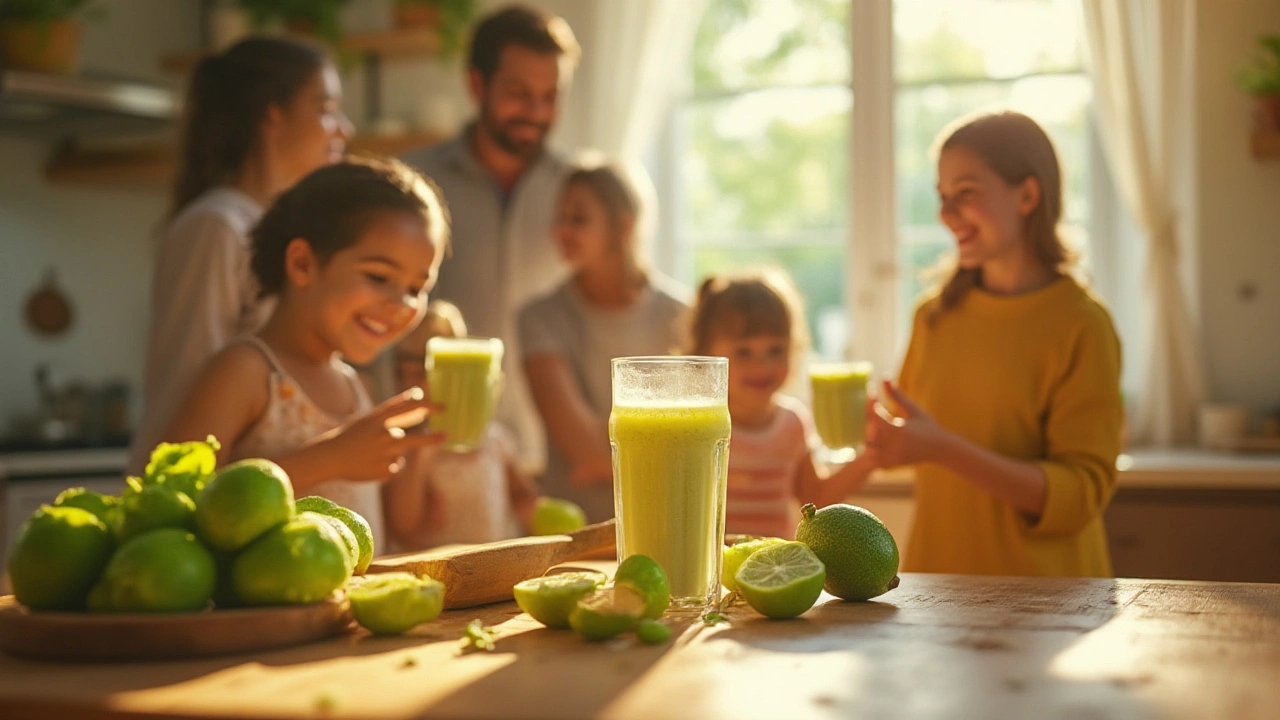There’s a tiny green fruit that packs more punch than your morning orange juice, outshines the kale in your smoothie, and gives most fancy supplements a run for their money. Indian gooseberry, or amla, is so legendary in India that people have built traditions (and even pickles) around it for centuries. The secret? This little sphere is crammed with vitamin C, antioxidants, and other nutrients so potent, some nutrition experts call it the ‘divine fruit’. You see amla popping up in shampoos and dietary supplements everywhere now, but does it live up to the hype? Read on and get ready to make some space in your pantry.
Why Indian Gooseberry is a Nutritional Powerhouse
Picture this: one humble gooseberry contains up to 20 times more vitamin C than an orange. It’s a big deal because, as you might know, vitamin C boosts immunity, helps heal wounds, and fights off cell-damaging free radicals. There’s even a study led by the National Institute of Nutrition in India proving that amla’s vitamin C remains stable even when it’s dried or cooked—unlike most other fruits, where vitamin C goes out the window the moment you heat them up. That means whether you drink it, cook it, or snack on amla straight from a jar, you’re still soaking up its benefits. But it’s not just about the C. Indian gooseberry is bursting with polyphenols, gallic acid, and flavonoids. Gallic acid—you’ll find it in green tea too—has been studied for its anti-inflammatory and anti-cancer properties. Amla also brings the mineral party: calcium, iron, and chromium are all hanging out in there. Chromium might not get the spotlight much, but it helps your body regulate blood sugar, which is why some people use amla as a natural aid for managing diabetes.
Let’s talk fiber. One serving of amla has enough fiber to support happy digestion and keep things moving along, if you know what I mean. High fiber means amla supports gut health, possibly even feeding those friendly bacteria that keep your tummy settled. There are also bioactive compounds like ellagic acid, which some small studies have linked to lower cholesterol levels. Don’t just take my word—check out the numbers in this table:
| Component | Per 100g of Amla |
|---|---|
| Vitamin C | ~600 mg |
| Fiber | ~4.3 g |
| Calcium | ~25 mg |
| Iron | ~1.2 mg |
| Energy | ~44 kcal |
All those numbers are decent reasons to give amla a try. And science seems to agree: an experiment published in the Journal of Medicinal Food in 2022 found that people who ate dried amla daily had better antioxidant levels and lower bad cholesterol within just 12 weeks.
Amla for Beauty: Glowing Skin, Glossy Hair, and More
If you’re into radiant skin and lustrous hair, amla should be on your radar. You’ll see Bollywood stars and beauty bloggers raving about how amla boosts their hair growth, makes strands shinier, and keeps their skin looking fresh. The reason? That vitamin C turbocharges collagen production, which makes skin look firm, smooth, and bouncy. And again, unlike a lot of trendy beauty supplements, amla is a real food you can eat, drink, or even slather on your face.
You can find dozens of high-end hair oils and masks touting Indian gooseberry oil as a star ingredient. Some use it to keep dandruff under control or add strength from root to tip. But eating amla, either raw, as a supplement, or even pickled (if you’re feeling adventurous), gives you benefits from the inside out. Some traditional Indian remedies recommend amla for slowing the appearance of grey hair, though research here is mostly anecdotal. Still, people who regularly take amla tend to report fewer split ends and better scalp health.
For the skin, amla has a reputation for fading dark spots and brightening complexion. Indian brides often drink amla juice or eat amla candies ahead of their wedding days—sort of a natural glow-up. One dermatology-focused study from 2023 found that participants who drank amla juice daily reported softer, smoother skin within two months. If you’re feeling ambitious, you can even mash amla pulp and mix it with yogurt as a DIY face mask (test on a small patch first, since it can tingle!).
The antioxidants don’t just keep you looking young; they defend your skin from everyday stress like pollution and sun exposure. Some evidence even suggests that topical amla extract may reduce UV-induced skin damage, though sunscreen is still your best line of defense. Curious about boosting your beauty regimen naturally? Indian gooseberry might be your new best friend.

The Health Benefits Beyond Beauty: Immunity, Blood Sugar, and More
Let’s shift gears from the beauty aisle to the medicine cabinet. Amla has earned its place in Ayurveda for thousands of years, and modern research is catching up. Its big claim to fame? Immunity. Because of all that vitamin C and those antioxidant compounds, eating amla regularly seems to help your body bounce back faster from everyday sniffles and colds. There’s even buzz that amla helps your body respond better to vaccines (2009 Indian Journal of Clinical Biochemistry) because it supports the production of white blood cells.
If you or someone you know is dealing with blood sugar swings, here’s something interesting: research on amla powder in both animals and small-scale human trials shows it can reduce fasting and post-meal blood glucose. In one 2021 Indian study, volunteers with early type 2 diabetes who took amla capsules daily for three months saw better blood sugar control compared to those who took a placebo. Just remember, no fruit is a magic cure, so check with your doctor before swapping out your meds.
Amla also shows promise for cholesterol and heart health. Its antioxidants help combat oxidation—the thing that makes "bad" LDL cholesterol more likely to stick to artery walls. Some findings suggest that taking amla supplements leads to lower total cholesterol and triglycerides, and at least one study from the International Journal of Cardiology pointed to improved artery flexibility in older adults who added amla to their diets.
Feeling stressed? One quirky but fascinating study measured the impact of taking amla on stress hormone levels and found a noticeable drop in cortisol. Whether you’re into yoga and meditation or just trying to keep your cool through deadlines and commutes, having a little amla on hand might not be a bad idea. Finally, some traditional uses include boosting liver function, helping with stomach ulcers, and supporting eyesight. Not every folk remedy is backed by solid research yet, but scientists are looking into all these things.
Oh, and if you ever wondered why some people age well, amla might be helping from the inside. The same combination of vitamins and polyphenols supports your body’s repair processes, potentially helping keep you feeling and looking younger. This fruit is basically a multitasker for your health.
How to Add Indian Gooseberry to Your Daily Routine
Alright, so you’re pumped about amla—how do you work it into your actual, real-life meals? Thankfully, you don’t have to book a flight to Mumbai. Today, you can find amla almost everywhere: fresh in Indian grocery stores, dried and candied at the health food aisle, and as capsules or powder online. If you want all the benefits but none of the tartness, look for amla supplements—most are standardized for vitamin C content, so you know what you’re getting. Just choose products from well-reviewed brands that do third-party testing.
Feeling adventurous? Here are a few friendly ways to make amla a part of your daily routine:
- Fresh amla: Rinse, slice, sprinkle with a pinch of salt and chili powder—makes a tangy snack or salad topper.
- Amla juice: Mix with water and a splash of honey. Start with a little—amla can be super sour!
- Dried/candied amla: Pop a few as a post-lunch pick-me-up or stir into trail mix.
- Amla powder: Blend into smoothies, yogurt, or oatmeal. This is the easiest move for busy mornings.
- Amla supplements: Read the label! Most adults do well with 500 mg to 1,000 mg daily, but check with your healthcare provider if you’re pregnant, breastfeeding, or managing a health condition.
If you love experimenting in the kitchen, amla also goes into Indian chutneys and pickles. Try adding amla powder to marinades or salad dressings for a flavorful twist with a major health boost. Amla can taste intense solo, so pair it with naturally sweet fruits like apples, pears, or even mangoes for balance. Want a beauty bonus? You can buy amla oil for scalp massages or hair masks—message me if you want my favorite blend.
One word of caution: too much of a good thing can be…well, too much. High doses of vitamin C may cause tummy upset, especially if you have sensitive digestion. If you’re on blood thinners or have a health issue where vitamin C interacts with medicine, double-check before starting anything new. For most healthy adults, though, a daily dose of amla—whether fresh, dried, or as a supplement—fits easily into a balanced diet and could be the missing link to glowing skin, stronger hair, and resilient health from the inside out.

Maria Romina Aguilar
July 19, 2025 AT 12:07Brandon Trevino
July 20, 2025 AT 02:19Denise Wiley
July 20, 2025 AT 05:18Hannah Magera
July 20, 2025 AT 11:31Michael Segbawu
July 22, 2025 AT 01:10Aarti Ray
July 23, 2025 AT 19:05Alexander Rolsen
July 25, 2025 AT 04:38Alexis Mendoza
July 25, 2025 AT 15:45Michelle N Allen
July 26, 2025 AT 20:06Madison Malone
July 27, 2025 AT 08:30Graham Moyer-Stratton
July 27, 2025 AT 20:56tom charlton
July 28, 2025 AT 02:35